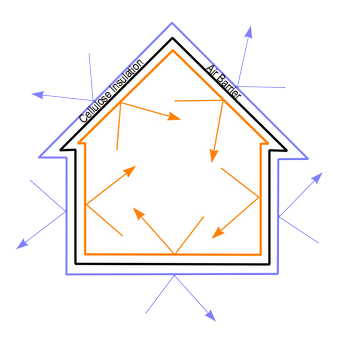Menu

A common misconception, even with industry professionals, is that all insulations require vapor barriers to protect from moisture. Fiberlite Technologies does not recommend the use of vapor barriers with cellulose insulation except in circumstances of exceptionally high moisture levels, such as for indoor pool rooms or spas. The reason is that cellulose is the only insulation that actually manages moisture naturally.
Moisture moves in two ways: air movement and diffusion. Of these two, air movement is the more significant accounting for over 98% of the total, and it is the primary cause for moisture related problems outside of floods and leaks. Cellulose insulation impedes the movement of air. By blocking the movement of moisture-laden air, cellulose insulation reduces moisture movement to manageable levels within a home or building. Any remaining moisture is diffused within the cellulose insulation, and will be further blocked by primers or paints used on the interior surfaces.
A vapor barrier is not only unnecessary but also can be potentially harmful, especially during the summer months in air-conditioned homes and buildings, when warm moist air passes through wall assemblies and condenses on the outside of the cool vapor barrier. The hygroscopic nature of cellulose insulation allows it to manage and wick moisture from areas of greater to lesser concentrations, thus preventing damaging amounts of moisture from accumulating.
Industry professionals are encouraged to contact FTI with questions about whether a vapor barrier is needed and for more information on the topic.(Sources: US Department Of Energy: Energy Efficiency and Renewable Energy – Moisture Control)